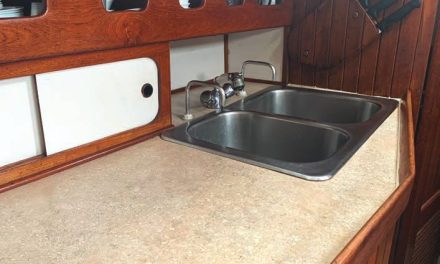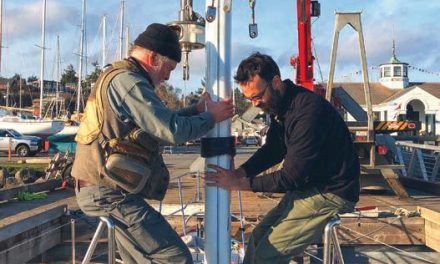
Simple or sophisticated, each type has its merits
When we bought our 45-foot Liberty cutter, Nine of Cups, in 2000, she needed a number of upgrades to convert her from a coastal sailer to a bluewater cruiser. One of those upgrades was to add solar panels. I did a lot of research and fitted her out with state-of-the-art panels and the best solar controller I could find.
Not surprisingly, the technology has changed considerably since then. Solar panels have seen an impressive increase in wattage per square foot while dropping in price. The biggest change, however, has been in solar controllers. In 2000, the options available for a marine application were fewer and much more expensive than today’s offerings. Many years later, when I was planning a new solar installation, and with the prices of the various controllers ranging from around $10 to several hundred dollars, I took another look at the technology. I wanted not only the best solution, but the best bang for the buck. Here’s what I found.
Direct connection
There are four ways to transfer the output of the solar panels to the batteries. The simplest way is to connect the solar panels directly to the battery. If the solar panels are very low wattage, this is sometimes an acceptable method to keep a battery bank topped up without too much risk of overcharging and damaging the batteries. A reasonable guideline is to connect no more than 5 watts of solar for every 50 amp-hours of battery capacity. For example, if the house battery bank has a total capacity of 400 amp-hours, the directly connected solar panels should not exceed 40 watts, and there must be a diode between the batteries and the solar panels. When the sun goes down, if there is no blocking diode in the circuit, current will flow from the batteries back to the solar panels, partially draining them. Some panels have a diode preinstalled, but not all.
Diverter
The diverter is essentially a direct connection between the solar panels and the batteries, but with the addition of a voltage monitor and relay. As long as the solar panel voltage is below the maximum charge voltage for the battery, the relay connects the two together. When the panel voltage exceeds the recommended battery- charge voltage, or the output voltage of the solar panels drops below the battery voltage, the relay disconnects the panels from the batteries. If desired, when the panels are disconnected from the batteries, the solar output can be automatically diverted to another load, such as the heating coil of a water heater.
This is the type of controller I installed on Nine of Cups in 2000, and I found that it did a rather poor job of charging the batteries. When the batteries were less than 80 percent charged, the controller passed all the solar output directly to the batteries, but when they were above about 80 percent of full charge, the solar panel voltage would quickly rise higher than the maximum allowable battery voltage and the relay would disconnect the panels. On a sunny afternoon, we could hear the relay switching the panels on and off every 10 to 15 seconds, wasting all that solar power, even though the batteries weren’t fully charged.
The cost of these controllers is on the high side, between $80 and $200, depending on the current rating required and the quality of the relay. Considering the other options now available, I can think of only two possible reasons for choosing a diverter: some types of wind generators require a diverter controller to prevent them from spinning too fast when the battery is charged, and the newer electronic controllers generate radio-frequency (RF) and electromagnetic (EM) noise that may interfere with an HF radio — more on this below.
PWM controller
The specification sheets for solar panels include a number of ratings: maximum power (Pmax), expressed in watts, short circuit current (Isc) in amps, and a host of others. The short circuit current or Isc is the maximum current that the solar panel can produce.
Assuming the solar panel is in full sun and at room temperature, as the battery is being charged, the current produced by the panel is going to stay slightly less than the Isc as the battery voltage slowly rises. As the charging cycle progresses, the battery voltage will continue to rise until it eventually reaches the recommended charge voltage, at which point the charge current should be reduced.
The diverter controller, discussed above, does this by disconnecting the panels from the batteries until the voltage drops back down below the recommended charge voltage. A pulse-width-modulator (PWM) controller does a similar thing, except that instead of disconnecting and reconnecting the batteries every 10 or 15 seconds, it disconnects the two at a rate more like 10,000 times a second.
The PWM controller can also vary the percentage of time that the battery is connected to the panel. For example, if the battery is connected 90 percent of the time, then the average charge current will be .9 x Isc. The designers incorporate a few more components to smooth out the switched current, and the end result is that the PWM controller monitors the battery voltage and varies the charge current from 0 amps to almost 100 percent of Isc as necessary. Pretty clever.
PWM controllers range in price from around $10 to upwards of $150, depending on the manufacturer, bells and whistles, and amperage rating, making them the least expensive option. But there are two drawbacks to these controllers.
While a PWM controller is more efficient than a diverter-type controller, it still leaves much to be desired. Anyone who’s been messing around with boat electrics for any length of time probably remembers that watts equals volts x amps. A typical 180-watt solar panel can produce a maximum current (Isc) of 9.6 amps. When charging a battery that is at 13.0 volts, and the solar is producing all it can at 9.6 amps, that 180-watt panel effectively becomes a 125-watt panel (13.0 volts x 9.6 amps). Rarely, if ever, does a solar panel reach its maximum wattage with a PWM controller. In fact, most of the sources I’ve seen indicate that PWM controllers reduce the output of a solar panel by 30 to 50 percent.
By design, PWM controllers switch large currents on and off, which makes them prime sources of RF and EM interference. Many of these controllers are designed for household or RV use, where a little noise isn’t a concern, but on a boat, they can cause a lot of interference with the onboard radios.

When David installed a solar battery charging system in the land yacht they now cruise in, he chose a Renogy MPPT controller to manage and monitor the charging process.
MPPT controller
Solar panels have a very narrow “sweet spot.” To get the most wattage from them, the output voltage and load current have to be controlled very tightly. A maximum power point tracking (MPPT) controller incorporates a microprocessor that tracks the panel’s sweet spot and makes sure the output voltage and current are optimal. Then it uses a DC-to-DC voltage converter to reduce the voltage to the required charge voltage for the battery, using a smart three-stage charging algorithm. Most also have an equalization mode. While a PWM may be clever, an MPPT controller is pure genius.
MPPT controllers are highly efficient, utilizing 90 to 98 percent of the rated wattage of a solar panel — a major improvement over the other types. In addition, most MPPT control- lers can handle a solar voltage of more than 100 volts, so solar panels can be used either in series or in parallel. Putting two solar panels in series versus in parallel doubles the operating voltage while halving the output current — the wattage remains the same. The result is that the wire size can be smaller, and that can yield significant cost savings.
Not surprisingly, there are also a couple of drawbacks with MPPT controllers. For one, the cost is higher. MPPT controllers range in price from just over $100 to upwards of $600, depending on features and wattage ratings. Like PWM controllers, MPPT controllers use switching power supplies to convert the DC voltage levels, and this can introduce RF and EM interference in radios.

The tracer meter allows him to set charge parameters and perform other functions.
Making the choice
In my opinion, it isn’t difficult to justify the higher cost of an MPPT controller. On most boats, the available real estate is the limiting factor for the amount of solar that can be added, and it makes sense to maximize the output of the panels. If more than one panel is installed, and they are installed in series, the savings in wire cost will offset some of the additional cost.
My new installation is a good example. I was space-limited to two 180-watt solar panels for a total of 360 watts. (For comparison, the original installation on Nine of Cups using 1999-vintage solar panels was 240 watts in the same space.)
If I had gone with a PWM controller, I would have purchased, at a cost of $80, a mid-priced product that was capable of handling the output of my solar panels. Since the panels would be in parallel, the amperage would be double that of a single panel, and the required wire size, using the tables for a 10 percent voltage drop, would be a minimum of AWG 8. The wire length needed was about 25 feet each way for a total of 50 feet. Using West Marine prices, the cost for marine-grade wire would be $70, for a total of $150, and the resulting output, given the inefficiencies of PWM controllers, would have been around 215 watts.
The MPPT controller I chose was a Renogy 40-Amp Commander at a cost of $250. Since the panels were in series, the amperage was less than it would be in a parallel installation. The required wire size of AWG 10 cost $26, for a total of $276 for the installation. The resulting output with the higher- efficiency MPPT controller was 330 watts. In this example, the MPPT option was $126 more expensive than the PWM, but performed more than 50 percent better.
After we’d used our new solar system for a few months, I was very impressed with its performance, especially when comparing it to the old system on Nine of Cups. We had a 12-volt DC fridge/freezer, and on a typical day, we powered a coffeemaker every morning, a microwave occa- sionally, lots of LED lights, a few battery-powered tools, 12-volt DC fans, and the usual laptops, tablets, and phones that require recharging. On sunny days, rarely did our battery bank dip below 80 percent of full charge, and it almost always reached full charge by midafternoon.
Resources
For tables showing wire size vs. wire length for voltage drops of 3 percent and 10 percent: westmarine.com/WestAdvisor/ Marine-Wire-Size-And-Ampacity





